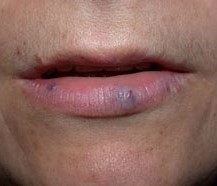Venous Lake
What is
Venous Lake?
Venous Lake,
also known medically as Phlebectasis is a dilation of a vein, soft, compressible,
dark blue to violaceous in colour. Venous Lakes tend to be isolated and commonly
found on sun-exposed surfaces of the vermilion border of the lip, face and
ears. These lesions can be flat or slightly dome-shaped.
What
causes a Venous Lake?
The cause of
Venous Lakes is still not completely understood. The most likely cause is
chronic sun damage to the walls of the superficial veins. This damage leads to
the dilation of veins on the surface of the skin resulting in an elevated, dark
blue papule. Venous Lakes are common and may affect more than one member of a
family, but they are not inherited, contagious or catching. They are benign and
more common in men than women.
How to
treat a Venous Lake?
The
treatment for Venous Lakes includes high frequency electrical current with a
laser, one treatment is usually standard, however if large in size more than one
treatment may be required. They are treated to improve the appearance or the
area and occasionally to prevent bleeding.
The
treatment is quick and simple with minor discomfort, involves first using the
Laser out of contact at low power for a few minutes for deep penetration into
the lesion which is rich in haemoglobin, the (Nd:Yag) or diode with an
uninitiated tip is the type of laser offered. After the lesion has absorbed
sufficient laser energy, the laser can then be used in contact to open the
tissue and remove the remaining dried blood. Procedure can be used on all skin
types and treatment is suitable for most people.

After care
Following your treatment,
you may experience:
A slight
reddening and/or swelling of the area.
Warmth in the
area that has been treated.
The area may
feel itchy as it heals.
The
area with scab as it heals – DO NOT PICK
Following
treatment ensure you follow the aftercare advice to avoid unwanted reactions or
infections:
-
Do not touch
the treated area and do not, under any circumstances remove the scabs
which will appear.
- Cooling the
skin with a moist cloth may comfort the area whenever a burning sensation
occurs but excessive cooling may lead to hypo pigmentation.
- Erythema
& Oedema are normal post treatment reactions and will disappear after
a couple of days.
- Avoid
swimming, saunas, steam rooms, facial steaming, facial scrubs, waxing and
other beauty treatments until the area has completely healed.
- Please keep
out of UV light as much as possible.
- Cover up with hats or parasol.
- The
area treated and any areas showing a predisposition to Skin tags should be
protected at all times particularly in the summer months. Use SPF 30
minimum
- Avoid using
any possible skin sensitizers or irritants such as perfumes, fake tan
products or perfumed body lotions around the area.
- Should you
have any concerns regarding your treatment please contact the Clinic.